The Scottish Government has today confirmed the tiers for each of the country’s local authorities.
Aberdeen and Aberdeenshire have been placed in level 2, with Highlands, islands and Moray in level 1.
Below are the five key indicators used to judge which level an area should be in. We also take a look at how the north and north-east rates for each of these metrics.
Number of new cases per 100,000 people
This metric helps the government understand the current state of the epidemic, if the number of new cases is high, compared to the population, the risk of it spreading and more people becoming seriously ill is greater.
The actual cases are likely to be even higher as not everybody with symptoms gets tested.
The figures are calculated based on the number of people in an area who have tested positive for the first time over a seven day period.
This is then divided by the population of that area, based on the NRS mid-year estimate for 2019, and multiplied by 100,000.
Test positivity rate
This reflects both the amount of testing and the prevalence of the virus in an area.
It is aligned with a criteria used by the World Health Organisation (WHO).
It is calculated by taking the number of positive tests in a seven day period, divided by the number of tests taken in an area, this gives a percentage.
Future number of cases per 100,000 people
This metric can identify hotspots across Scotland where infections are likely to be high in two weeks’ time, and acts as an early warning system.
According to the Sottish Government, two weeks is close enough for them to be relatively sure how many people in an area will be infected.
It’s predicted using modelling data which assumes no change based on current interventions. The probability of an area exceeding 500, 300, 100 or 50 cases per 100,000 is calculated.
If an area has a 75% chance or greater of exceeding the threshold for a level it is placed in that tier.
Number of people likely to need acute hospital care in future weeks
This indicator shows areas where is there is a significant risk of an area exceeding local acute hospital capacity in the next six weeks.
Across Scotland, there are around 3,000 beds available to treat Covid-19 patients. This can be affected by other winter-related pressures such as more people going to A&E, staff absences and a greater need for infection control measures.
This figure is estimated using modelling techniques and is compared to the number of beds available.
It is calculated by health board areas and then applied to local authorities. The level is then estimated by how long it is predicted there is enough beds for, based on current restrictions.
Number of people likely to need intensive care in future weeks
This metric highlights areas where there is a significant risk of exceeding the total capacity in intensive care units (ICU) in the next five weeks.
In Scotland there are around 360 ICU beds available for Covid-19 patients. As in the metric above, this number may change based on other pressures.
To increase the number of available beds, operations may need to be cancelled. The total number of available beds could reach 700 if needed.
It is calculated by estimating the number of people likely to need an ICU bed over the next five weeks, and compares that figure to the number of beds available.
As before, this is calculated by health boards, before being applied to local authorities.
